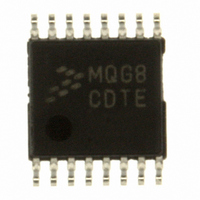MC9S08QG8CDTE Freescale Semiconductor, MC9S08QG8CDTE Datasheet - Page 210

MC9S08QG8CDTE
Manufacturer Part Number
MC9S08QG8CDTE
Description
IC MCU 8K FLASH 10MHZ 16-TSSOP
Manufacturer
Freescale Semiconductor
Series
HCS08r
Datasheet
1.MC9S08QG8CDTER.pdf
(314 pages)
Specifications of MC9S08QG8CDTE
Core Processor
HCS08
Core Size
8-Bit
Speed
20MHz
Connectivity
I²C, SCI, SPI
Peripherals
LVD, POR, PWM, WDT
Number Of I /o
12
Program Memory Size
8KB (8K x 8)
Program Memory Type
FLASH
Ram Size
512 x 8
Voltage - Supply (vcc/vdd)
1.8 V ~ 3.6 V
Data Converters
A/D 8x10b
Oscillator Type
Internal
Operating Temperature
-40°C ~ 85°C
Package / Case
16-TSSOP
Cpu Family
HCS08
Device Core Size
8b
Frequency (max)
20MHz
Interface Type
I2C/SCI/SPI
Total Internal Ram Size
512Byte
# I/os (max)
12
Number Of Timers - General Purpose
1
Operating Supply Voltage (typ)
2.5/3.3V
Operating Supply Voltage (max)
3.6V
Operating Supply Voltage (min)
1.8V
On-chip Adc
8-chx10-bit
Instruction Set Architecture
CISC
Operating Temp Range
-40C to 85C
Operating Temperature Classification
Industrial
Mounting
Surface Mount
Pin Count
16
Package Type
TSSOP
Processor Series
S08QG
Core
HCS08
Data Bus Width
8 bit
Data Ram Size
512 B
Maximum Clock Frequency
20 MHz
Number Of Programmable I/os
12
Number Of Timers
1
Operating Supply Voltage
1.8 V to 3.6 V
Maximum Operating Temperature
+ 85 C
Mounting Style
SMD/SMT
3rd Party Development Tools
EWS08
Development Tools By Supplier
DEMO9S08QG8E
Minimum Operating Temperature
- 40 C
Package
16TSSOP
Family Name
HCS08
Maximum Speed
20 MHz
For Use With
DEMO9S08QG8E - BOARD DEMO FOR MC9S08QG8
Lead Free Status / RoHS Status
Lead free / RoHS Compliant
Eeprom Size
-
Lead Free Status / Rohs Status
Compliant
Available stocks
Company
Part Number
Manufacturer
Quantity
Price
Company:
Part Number:
MC9S08QG8CDTE
Manufacturer:
ABB
Quantity:
101
Company:
Part Number:
MC9S08QG8CDTE
Manufacturer:
Freescale Semiconductor
Quantity:
41 991
Part Number:
MC9S08QG8CDTE
Manufacturer:
FREESCALE
Quantity:
20 000
Serial Communications Interface (S08SCIV3)
masked by local interrupt enable masks. The flags can still be polled by software when the local masks are
cleared to disable generation of hardware interrupt requests.
The SCI transmitter has two status flags that optionally can generate hardware interrupt requests. Transmit
data register empty (TDRE) indicates when there is room in the transmit data buffer to write another
transmit character to SCID. If the transmit interrupt enable (TIE) bit is set, a hardware interrupt will be
requested whenever TDRE = 1. Transmit complete (TC) indicates that the transmitter is finished
transmitting all data, preamble, and break characters and is idle with TxD1 high. This flag is often used in
systems with modems to determine when it is safe to turn off the modem. If the transmit complete interrupt
enable (TCIE) bit is set, a hardware interrupt will be requested whenever TC = 1. Instead of hardware
interrupts, software polling may be used to monitor the TDRE and TC status flags if the corresponding
TIE or TCIE local interrupt masks are 0s.
When a program detects that the receive data register is full (RDRF = 1), it gets the data from the receive
data register by reading SCID. The RDRF flag is cleared by reading SCIS1 while RDRF = 1 and then
reading SCID.
When polling is used, this sequence is naturally satisfied in the normal course of the user program. If
hardware interrupts are used, SCIS1 must be read in the interrupt service routine (ISR). Normally, this is
done in the ISR anyway to check for receive errors, so the sequence is automatically satisfied.
The IDLE status flag includes logic that prevents it from getting set repeatedly when the RxD1 line
remains idle for an extended period of time. IDLE is cleared by reading SCIS1 while IDLE = 1 and then
reading SCID. After IDLE has been cleared, it cannot become set again until the receiver has received at
least one new character and has set RDRF.
If the associated error was detected in the received character that caused RDRF to be set, the error flags
— noise flag (NF), framing error (FE), and parity error flag (PF) — get set at the same time as RDRF.
These flags are not set in overrun cases.
If RDRF was already set when a new character is ready to be transferred from the receive shifter to the
receive data buffer, the overrun (OR) flag gets set instead and the data and any associated NF, FE, or PF
condition is lost.
14.4
Additional SCI Functions
The following sections describe additional SCI functions.
14.4.1
8- and 9-Bit Data Modes
The SCI system (transmitter and receiver) can be configured to operate in 9-bit data mode by setting the
M control bit in SCIC1. In 9-bit mode, there is a ninth data bit to the left of the MSB of the SCI data
register. For the transmit data buffer, this bit is stored in T8 in SCIC3. For the receiver, the ninth bit is held
in R8 in SCIC3.
For coherent writes to the transmit data buffer, write to the T8 bit before writing to SCID.
MC9S08QG8 and MC9S08QG4 Data Sheet, Rev. 5
208
Freescale Semiconductor











